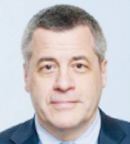
Bob S. Carter, MD, PhD
IN A PILOT study of recurrent glioma, 26% of patients treated with the optimal dose of vocimagene amiretroprepvec (aka Toca 511), a novel oncolytic virus therapy, achieved durable, long-term responses and remained alive 3 or more years later. This outcome far exceeded “historical benchmarks” for this poor-prognosis population, according to lead researcher Bob S. Carter, MD, PhD, the William and Elizabeth Sweet Professor and Chief of Neurosurgery at Massachusetts General Hospital, Boston.
“Median duration of response in this subset has not been reached, after a median follow-up of 37 months,” Dr. Carter reported at the 2018 Annual Meeting of the American Association of Neurological Surgeons (AANS).1
Vocimagene Amiretroprepvec
VOCIMAGENE AMIRETROPREPVEC is an investigational retroviral-based vector that selectively infects dividing cancer cells, integrates into the genome, and replicates due to immune defects in tumors. The treatment involves administration of the viral vector into the resection cavity and then delivery of a chemotherapeutic agent.
Vocimagene amiretroprepvec spreads through tumors and stably delivers the gene encoding an optimized yeast cytosine deaminase that converts the oral prodrug flucytosine, an antifungal, into the chemotherapeutic agent fluorouracil (5-FU). The 5-FU kills cancer cells, myeloid-derived suppressor cells, and tumor-associated macrophages. This enables immune activity against the tumor, Dr. Carter explained.
This combination has proven powerful in preclinical models, where mice that respond to the therapy are able to resist the challenge of further tumor cell injections. Additionally, when T cells from these “cured” mice are transferred to naive mice that bear the tumor but have not received treatment, the adoptively transferred T cells also trigger tumor regression, which is consistent with an immune mechanism for this therapeutic.
“The data suggest a positive association of durable response [to vocimagene amiretroprepvec] with overall survival.”— Bob S. Carter, MD, PhD
Tweet this quote
Phase I Study
THIS WAS A multicenter phase I dose-escalation study in 56 patients with recurrent glioma (80% high-grade) who underwent resection. Among this group, 23 patients received higher (optimal) doses, the regimen chosen for the subsequent phase III trial. This was the first recurrence in half the patients, but the other half had had multiple recurrences, and standard therapies had failed.
Resection was followed by one administration of vocimagene amiretroprepvec (in escalating doses per cohort), then multiple courses of the virus along with oral flucytosine. Objective responses, as assessed by independent radiology review, were observed 6 to 19 months after treatment, which supports the concept of an immunologic mechanism at work, Dr. Carter said.
The objective response rate was 34%, the clinical benefit rate (at 8 weeks) was 30%, and 11% of patients maintained durable responses for 24 weeks or longer. All durable responses were seen in the six patients who achieved complete responses, which included two patients with IDH1 mutations and four IDH1 wild-type patients. This suggests the drug may have benefit “across the recurrent high-grade glioma setting,” he maintained.
Higher response rates and greater durability of responses were seen in the optimally dosed patients. In the 23-patient subgroup who received the recommended phase III vocimagene amiretroprepvec dose, there were 5 complete responses (of 6 durable responses in the total population), and median overall survival was 14.4 months.
“All responders were alive, [for a period ranging] from 38 months to 57.5 months…. The data suggest a positive association of durable response with overall survival,” Dr. Carter said. As he pointed out, these results “compare favorably” with lomustine (Gleostine) in recurrent disease, where overall response rates have been less than 5% and duration of response, approximately 3 to 10 months.
Adverse events related to vocimagene amiretroprepvec were rare across all grades, with fatigue as the primary complaint (11%). Events related to the flucytosine component were also uncommon, with fatigue (22%), diarrhea (13%), and nausea (9%) being the most reported.
The 380-patient phase III TOCA5 study is currently enrolling patients after a first or second recurrence who have not had bevacizumab (Avastin) and whose tumors are ≤ 5 cm. Patients will be randomly assigned to receive the oncolytic virus therapy, chemotherapy (lomustine or temozolomide), or bevacizumab.
“The clinical activity and mechanism of action data support Breakthrough Therapy designation and PRIME designation [from the European Medicines Agency],” he added.
‘Impressive,’ but Caution Advised

Frederick Barker, MD
FREDERICK BARKER, MD, of Massachusetts General Hospital, commented on the failure so far of immunotherapies in gliomas, presumably because these tumors have few neoantigens and few tumor-infiltrating lymphocytes, compared to other malignancies, and “immunologically cold tumors cannot be expected to respond to immunotherapy.”
Viral therapy has been proposed as a means of turning these “cold” tumors into “hot” ones by changing the immune homeostasis within those tumors to one that favors an antitumor response, he said. Toca 511 is a viral immunotherapy that is designed to do so.
“This phase I trial showed limited serious toxicity, and thus achieved its goal of safety. A phase I trial can also suggest a treatment benefit, and here, treated patients lived modestly longer than historical controls, though with few treated patients, it is hard to gauge the strength of this evidence,” he said.

James M. Markert, MD
James M. Markert, MD, of the University of Alabama, Birmingham, the invited discussant of the study, urged caution in interpreting the findings but thought it achieved its phase I goals.
“This regimen resulted in an impressive frequency of durable responses to treatment, even for patients with a third recurrence,” Dr. Markert observed. “But interpretation of these studies does require some caution.”
He suggested that patients in this study may be different from historical controls in multiple ways, such as in tumor size, resectability, and histology. In other words, they may have had a better prognosis at baseline, he said. “Nonetheless, five complete durable responses in this heavily pretreated group is impressive, and we look forward to results from the ongoing phase III study,” he commented.
“While some long-term survivors also had imaging responses, we can’t claim this as additional evidence that the treatment works,” he said. “Imaging responses began nearly a year after treatment, when most nonresponders had already died. Independent factors, such as IDH1 mutation or robust intrinsic patient immune status, may explain response and survival. Clearly, however, further study of this agent is supported by this work.” ■
DISCLOSURE: Dr. Carter has consulted with Tocagen on the design of the phase III trial of vocimagene amiretroprepvec. Dr. Markert has a financial relationship with Catherex and Aettis. Dr. Barker reported no conflicts of interest.
REFERENCE
1. Carter B: Evaluation of durable response rate in the post-resection setting and association with survival in patients with recurrent high-grade glioma who received vocimagene amiretroprepvec and 5-fluorocytosine treatment. 2018 Annual Meeting of the American Association of Neurological Surgeons. Abstract 615. Presented May 1, 2018.

